Cuba: Changes, Challenges, relationship with the United States
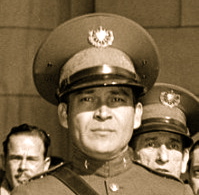
Cuba: Changes, Challenges, and its relationship with the United States
 Marty Moss-Coane guests today: Peter Schechter and Michael Reid
Marty Moss-Coane guests today: Peter Schechter and Michael Reid
A recent survey found that the majority of Americans favor increased ties with Cuba. This sentiment marks a major shift in attitudes toward the country. Inside Cuba, change is also taking place including the rise in private enterprise, the easing of travel laws, and much more. In this hour of Radio Times, we’ll discuss Cuban-American relations, what’s happening on the island, and what the future holds for the nation. Our guests are Peter Schechter, the first director of the Atlantic Council’s Adrienne Arsht Latin America Center, and Michael Reid, writer of the Bello column on Latin America for The Economist and the newspaper’s writer-at-large for the region.
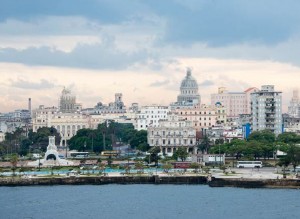 Cuba and the United States of America have had an interest in one another since well before either of their independence movements. Plans for purchase of Cuba from the Spanish Empire were put forward at various times by the United States. As the Spanish influence waned in the Caribbean, the United States gradually gained a position of economic and political dominance over the island, with the vast majority of foreign investment holdings and the bulk of imports and exports in its hands, as well as a strong influence on Cuban political affairs.
Cuba and the United States of America have had an interest in one another since well before either of their independence movements. Plans for purchase of Cuba from the Spanish Empire were put forward at various times by the United States. As the Spanish influence waned in the Caribbean, the United States gradually gained a position of economic and political dominance over the island, with the vast majority of foreign investment holdings and the bulk of imports and exports in its hands, as well as a strong influence on Cuban political affairs.
Following the Cuban Revolution of 1959, relations deteriorated substantially and have been marked by tension and confrontation since. The United States does not have formal diplomatic relations with Cuba and has maintained an embargo which makes it illegal for U.S. corporations to do business with Cuba. U.S. diplomatic representation in Cuba is handled by the United States Interests Section in Havana and there is a similar Cuban Interests Section in Washington D.C; both are officially part of the respective embassies of Switzerland. The United States imposed the embargo because of the nationalization of US corporations’ property during the Revolution, and has stated it will continue it so long as the Cuban government continues to refuse to move toward democratization and greater respect for human rights, hoping to see democratization and a reintroduction of capitalism of the type that took place in Eastern Europe after the revolutions of 1989.
The rise of General Fulgencio Batista in the 1930’s to de facto leader and President of Cuba for two terms (1940–44 and 1952–59) led to an era of close co-operation between the governments of Cuba and the United States. The United States and Cuba signed the Treaty of Relations in 1934. Batista’s second term as President was initiated by a military coup planned in Florida, and U. S. President Harry S. Truman quickly recognized Batista’s return to rule providing military and economic aid. The Batista era witnessed the almost complete domination of Cuba’s economy by the United States, as the number of American corporations continued to swell, though corruption was rife and Havana also became a popular sanctuary for American organized crime figures, notably hosting the infamous Havana Conference in 1946. U.S. Ambassador to Cuba Arthur Gardner later described the relationship between the U.S. and Batista during his second term as President:
As armed conflict broke out in Cuba between rebels led by Fidel Castro and the Batista government, the U.S. was urged to end arms sales to Batista by Cuban president-in-waiting Manuel Urrutia Lleó. Washington made the critical move in March 1958 to prevent sales of rifles to Batista’s forces, thus changing the course of the revolution irreversibly towards the rebels. The move was vehemently opposed by U.S. ambassador Earl T. Smith, and led U.S. state department advisor William Wieland to lament that “I know Batista is considered by many as a son of a bitch… but American interests come first… at least he was our son of a bitch.”
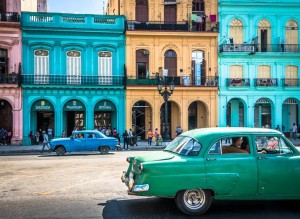 Post-Revolution Relations – Bay of Pigs Invasion and Cuban Missile Crisis
Post-Revolution Relations – Bay of Pigs Invasion and Cuban Missile Crisis
Until Castro, the U.S. was so overwhelmingly influential in Cuba that the American ambassador was the second most important man, sometimes even more important than the Cuban president.
— Earl T. Smith, former American Ambassador to Cuba, during 1960 testimony to the U.S. Senate
U.S. President Dwight D. Eisenhower officially recognized the new Cuban government after the 1959 Cuban Revolution which had overthrown the Batista government, but relations between the two governments deteriorated rapidly. Within days Earl T. Smith, U.S. Ambassador to Cuba, resigned his post to be replaced by Philip Bonsal. The US government became increasingly concerned by Cuba’s agrarian reforms and the nationalization of US owned industries. Between April 15 and 26, 1959, Fidel Castro and a delegation of representatives visited the U.S. as guests of the Press Club. This visit was perceived by many as a charm offensive on the part of Castro and his recently initiated government, and his visit included laying a wreath at the Lincoln memorial. After a meeting between Castro and Vice-President Richard Nixon, where Castro outlined his reform plans for Cuba, the US began to impose gradual trade restrictions on the island. On September 4, 1959, Ambassador Bonsal met with Cuban Premier Fidel Castro to express “serious concern at the treatment being given to American private interests in Cuba both agriculture and utilities.”
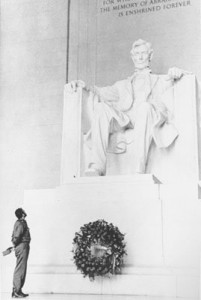 Fidel Castro laying a wreath at the Lincoln Memorial in Washington, 1959
Fidel Castro laying a wreath at the Lincoln Memorial in Washington, 1959
As state intervention and take-over of privately owned businesses continued, trade restrictions on Cuba increased. The U.S. stopped buying Cuban sugar and refused to supply its former trading partner with much needed oil, with a devastating effect on the island’s economy. In March 1960, tensions increased when the freighter La Coubre exploded in Havana harbor, killing over 75 people. Fidel Castro blamed the United States and compared the incident to the sinking of the Maine, though admitting he could provide no evidence for his accusation. That same month, President Eisenhower quietly authorized the Central Intelligence Agency (CIA) to organize, train, and equip Cuban refugees as a guerrilla force to overthrow Castro.
Each time the Cuban government nationalized American properties, the American government took countermeasures, resulting in the prohibition of all exports to Cuba on October 19, 1960. Consequently, Cuba began to consolidate trade relations with the Soviet Union, leading the US to break off all remaining official diplomatic relations. Later that year, U.S. diplomats Edwin L. Sweet and William G. Friedman were arrested and expelled from the island having been charged with “encouraging terrorist acts, granting asylum, financing subversive publications and smuggling weapons”. On January 3, 1961 the US withdrew diplomatic recognition of the Cuban government and closed the embassy in Havana.
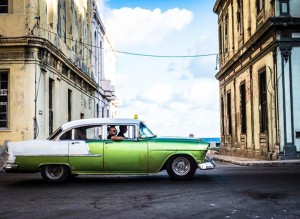 Presidential candidate John F. Kennedy believed that Eisenhower’s policy toward Cuba had been mistaken. He criticized what he saw as use of the U.S. government influence to advance the interest and increase the profits of private U.S. companies instead of helping Cuba to achieve economic progress, saying that Americans dominated the island’s economy and had given support to one of the bloodiest and most repressive dictatorships in the history of Latin America. “We let Batista put the U.S. on the side of tyranny, and we did nothing to convince the people of Cuba and Latin America that we wanted to be on the side of freedom.”
Presidential candidate John F. Kennedy believed that Eisenhower’s policy toward Cuba had been mistaken. He criticized what he saw as use of the U.S. government influence to advance the interest and increase the profits of private U.S. companies instead of helping Cuba to achieve economic progress, saying that Americans dominated the island’s economy and had given support to one of the bloodiest and most repressive dictatorships in the history of Latin America. “We let Batista put the U.S. on the side of tyranny, and we did nothing to convince the people of Cuba and Latin America that we wanted to be on the side of freedom.”
In 1961 Cuba resisted an armed invasion by about 1,500 CIA trained Cuban exiles at the Bay of Pigs. President John F. Kennedy‘s complete assumption of responsibility for the venture, which provoked a popular reaction against the invaders, proved to be a further propaganda boost for the Cuban government. The U.S. began the formulation of new plans aimed at destabilizing the Cuban government. These activities were collectively known as the “Cuban Project” (also known as Operation Mongoose). This was to be a coordinated program of political, psychological, and military sabotage, involving intelligence operations as well as assassination attempts on key political leaders. The Cuban project also proposed attacks on mainland US targets, hijackings and assaults on Cuban refugee boats to generate U.S. public support for military action against the Cuban government, these proposals were known collectively as Operation Northwoods.
A U.S. Senate Select Intelligence Committee report later confirmed over eight attempted plots to kill Castro between 1960 and 1965, as well as additional plans against other Cuban leaders. After weathering the failed Bay of Pigs invasion, Cuba observed as U.S. armed forces staged a mock invasion of a Caribbean island in 1962 named Operation Ortsac. The purpose of the invasion was to overthrow a leader whose name, Ortsac, was Castro spelled backwards. Tensions between the two nations reached their peak in 1962, after U.S. reconnaissance aircraft photographed the Soviet construction of intermediate-range missile sites. The discovery led to the Cuban Missile Crisis.
Trade relations also deteriorated in equal measure. In 1962, President John F. Kennedy broadened the partial trade restrictions imposed after the revolution by Eisenhower to a ban on all trade with Cuba, except for non-subsidized sale of foods and medicines. A year later travel and financial transactions by U.S. citizens with Cuba was prohibited. The United States embargo against Cuba was to continue in varying forms and is still in operation today.
Relations began to thaw during President Lyndon B. Johnson’s tenure continuing through the next decade and a half. In 1964 Fidel Castro sent a message to Johnson encouraging dialogue, he wrote:
“I seriously hope that Cuba and the United States can eventually respect and negotiate our differences. I believe that there are no areas of contention between us that cannot be discussed and settled within a climate of mutual understanding. But first, of course, it is necessary to discuss our differences. I now believe that this hostility between Cuba and the United States is both unnatural and unnecessary – and it can be eliminated.”
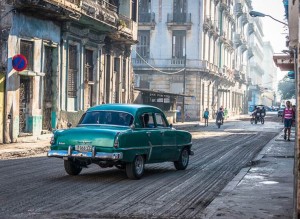 Through the late 1960’s and early 1970’s a sustained period of aircraft hijackings between Cuba and the US by citizens of both nations led to a need for cooperation. By 1974, U.S. elected officials had begun to visit the island. Three years later, during the Carteradministration, the U.S. and Cuba simultaneously opened interests sections in each other’s capitals. In 1980, after 10,000 Cubans crammed into the Peruvian embassy seeking political asylum, Castro stated that any who wished to do so could leave Cuba, in what became known as the Mariel boatlift. Approximately 125,000 people left Cuba for the United States. Among these political and economic refugees, Castro, without advising the U.S. government, included mental patients and criminals released from Cuban prisons.
Through the late 1960’s and early 1970’s a sustained period of aircraft hijackings between Cuba and the US by citizens of both nations led to a need for cooperation. By 1974, U.S. elected officials had begun to visit the island. Three years later, during the Carteradministration, the U.S. and Cuba simultaneously opened interests sections in each other’s capitals. In 1980, after 10,000 Cubans crammed into the Peruvian embassy seeking political asylum, Castro stated that any who wished to do so could leave Cuba, in what became known as the Mariel boatlift. Approximately 125,000 people left Cuba for the United States. Among these political and economic refugees, Castro, without advising the U.S. government, included mental patients and criminals released from Cuban prisons.
In 1977, Cuba and the United States signed a maritime boundary treaty in which the countries agreed on the location of their border in the Straits of Florida. The treaty was never sent to the United States Senate for ratification, but the agreement has been implemented by the U.S. State Department.
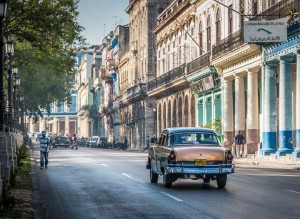 In 1981 President Ronald Reagan’s new administration announced a tightening of the embargo. The U.S. also re-established the travel ban, prohibiting U.S. citizens from spending money in Cuba. The ban was later supplemented to include Cuban government officials or their representatives visiting the U.S. In 1985 Radio y Televisión Martí, backed by Ronald Reagan’s administration, began to broadcast news and information from the U.S. to Cuba.
In 1981 President Ronald Reagan’s new administration announced a tightening of the embargo. The U.S. also re-established the travel ban, prohibiting U.S. citizens from spending money in Cuba. The ban was later supplemented to include Cuban government officials or their representatives visiting the U.S. In 1985 Radio y Televisión Martí, backed by Ronald Reagan’s administration, began to broadcast news and information from the U.S. to Cuba.
On February 24, 1996, two unarmed Cessna 337’s flown by the group “Brothers to the Rescue” were shot down by Cuban Air Force MiG-29, killing four Americans. The Cuban government claimed that the planes had entered into Cuban airspace.
In 2001, five Cuban agents were convicted on 26 counts of espionage, conspiracy to commit murder, and other illegal activities in the United States. On June 15, 2009, the U.S. Supreme Court denied review of their case.
Some veterans of CIA’s 1961 Bay of Pigs invasion, while no longer being sponsored by the CIA, are still active, though they are now in their seventies or older. Members of Alpha 66, an anti-Castro paramilitary organization, continue to practice their AK-47 skills in a camp in South Florida.
United States Embargo Against Cuba
The long standing U.S. embargo was reinforced in October 1992 by the Cuban Democracy Act (the “Torricelli Law”) and in 1996 by the Cuban Liberty and Democracy Solidarity Act (known as the Helms-Burton Act). The 1992 act prohibited foreign-based subsidiaries of U.S. companies from trading with Cuba, travel to Cuba by U.S. citizens, and family remittances to Cuba. Sanctions may also be applied to non-U.S. companies trading with Cuba. As a result, multinational companies have to choose between Cuba and the U.S., the latter being a much larger market. One important exception is the German-owned delivery company DHL Express. This restriction also applies to maritime shipping, as ships docking at Cuban ports are not allowed to dock at U.S. ports for six months. On October 10, 2006, the United States announced the creation of a task force made up of officials from several US agencies that will pursue more aggressively American violators of the US trade embargo against Cuba, with penalties as severe as 10 years of prison and hundreds of thousands of dollars in fines for violators of the embargo.
Recent Relations
In January 1999, U.S. President Bill Clinton eased travel restrictions to Cuba in an effort to increase cultural exchanges between the two nations. The Clinton administration approved a two-game exhibition series between the Baltimore Orioles and Cuban national baseball team, marking the first time a Major League Baseball team played in Cuba since 1959.
At the United Nations Millennium Summit in September 2000, Castro and Clinton spoke briefly at a group photo session and shook hands. U.N. Secretary-General Kofi Annan commented afterwards, “For a U.S. president and a Cuban president to shake hands for the first time in over 40 years—I think it is a major symbolic achievement.” While Castro said it was a gesture of “dignity and courtesy,” the White House denied the encounter was of any significance. In November 2001, US companies began selling food to the country for the first time since Washington imposed the trade embargo after the revolution. In 2002, former U.S. President Jimmy Carterbecame the first former or sitting U.S. president to visit Cuba since 1928.
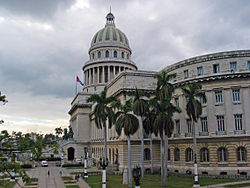 The Capitolio Nacional in Havana, built in 1929 and said to be a modeled on the Capitol building in Washington, D.C.
The Capitolio Nacional in Havana, built in 1929 and said to be a modeled on the Capitol building in Washington, D.C.
Relations deteriorated again following the election of George W. Bush. During his campaign Bush appealed for the support of Cuban-Americans by emphasizing his opposition to the government of Fidel Castro and supporting tighter embargo restrictions Cuban Americans, who generally vote Republican, expected effective policies and greater participation in the formation of policies regarding Cuba-US relations. Approximately three months after his inauguration, the Bush administration began expanding travel restrictions. The United States Department of the Treasury issued greater efforts to deter American citizens from illegally traveling to the island. In a 2004 meeting with members of the Commission for Assistance to a Free Cuba, President Bush stated, “We’re not waiting for the day of Cuban freedom; we are working for the day of freedom in Cuba.” The President reaffirmed his commitment to Cuban-Americans just in time for his 2004 reelection with promises to “work” rather than wait for freedom in Cuba. Following his 2004 reelection, George W. Bush declared Cuba to be one of the few “outposts of tyranny” remaining in the world. Tensions heightened as the Under Secretary of State for Arms Control and International Security Affairs, John R. Bolton, accused Cuba of maintaining a biological weapons program. Many in the US, including ex-president Carter, expressed doubts about the claim. Later, Bolton was criticized for pressuring subordinates who questioned the quality of the intelligence John Bolton had used as the basis for the assertion. Bolton identified the Castro government as part of America’s “axis of evil,” highlighting the fact that the Cuban leader visited several US foes, including Libya, Iranand Syria. Cuba was also identified as a State Sponsor of Terrorism by the United States Department of State. The Cuban government denies the claim, and in turn has accused the U.S. of engaging in state sponsored terrorism against Cuba.
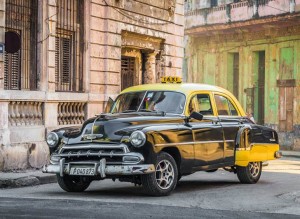 In January 2006, United States Interests Section in Havana began displaying messages on a scrolling “electronic billboard” in the windows of their top floor. Following a protest march organized by the Cuban government, the government erected a large number of poles, carrying black flags with single white stars, obscuring the messages.
In January 2006, United States Interests Section in Havana began displaying messages on a scrolling “electronic billboard” in the windows of their top floor. Following a protest march organized by the Cuban government, the government erected a large number of poles, carrying black flags with single white stars, obscuring the messages.
On September 8, 2006, it was revealed that at least ten South Florida journalists received regular payments from the U.S. government for programs on Radio Martí and TV Martí, two broadcasters that support an opening of Cuban society and multi-party elections in Cuba. The payments totaled thousands of dollars over several years. Those who were paid the most were veteran reporters and a freelance contributor for El Nuevo Herald, the Spanish-language newspaper published by the corporate parent of The Miami Herald. The Cuban government has long contended that some South Florida Spanish-language journalists were on the federal payroll.
On September 12, 2006, the United States announced that it had created five inter-agency working groups to monitor Cuba. The groups were set up after the July 31 announcement that the ailing Cuban leader had temporarily ceded power to a collective leadership headed by his brother Raúl. U.S. officials say three of the newly created groups are headed by the State Department: diplomatic actions; strategic communications and democratic promotion. Another that coordinated humanitarian aid to Cuba is run by the Commerce Department, and a fifth, on migration issues, is run jointly by the National Security Council and the Department of Homeland Security.
Recently, U.S. Congressional auditors have accused the development agency USAID of failing properly to administer its program to for promoting democracy in Cuba. They said USAID had channeled tens of millions of dollars through exile groups in Miami, which were sometimes wasteful or kept questionable accounts. The report said the organizations had sent items such as chocolate and cashmere jerseys to Cuba. Their report concludes that 30% of the exile groups who received USAID grants showed questionable expenditures.
In April 2009 U.S. President Barack Obama began implementing a less strict policy towards Cuba. The U.S. president had stated that he is open to dialogue with Cuba, but that he would only lift the trade embargo if Cuba has political change. In March 2009, Obama signed into law a Congressional spending bill which eased some economic sanctions on Cuba and eased travel restrictions on Cuban Americans (defined as persons with a relative “who is no more than three generations removed from that person”) traveling to Cuba. The April executive-branch changes further removed time limits on Cuban American travel to the island. Another restriction loosened in April or 2009 was in the realm of telecommunications, which would allow quicker and easier access to the internet for Cuba. The loosening of restrictions is likely to help nonprofits and scientists from both countries who work together on issues of mutual concern, such as destruction of shared biodiversity. At the 2009 5th Summit of the Americas, President Obama signaled the opening of a new beginning with Cuba. On 27 July 2012, Raúl Castro said that the Cuban government is willing to hold talks with the United States government to “discuss anything.” On December 10, 2013, in an unprecedented move at a state memorial service for Nelson Mandela, Barack Obama and Raul Castro shook hands, with Castro saying in English: “Mr. President, I am Castro.” Though both sides played down the handshake, an advisor to Obama said that Obama wants to improve relations with Cuba, yet has concerns about human rights on the island.
http://whyy.org/cms/radiotimes/2014/03/13/cuba-changes-challenges-and-its-relationship-with-the-united-states/


